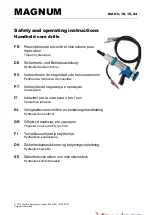
7 - English
OPERATION
INSTALLING/REMOVING BATTERY PACK
See Figure 5, page 12.
Lock the switch trigger.
Insert the battery pack into the product as shown.
Make sure the latches on each side of the battery pack
snap into place and that battery pack is secured in the
product before beginning operation.
Depress the latches to remove the battery pack.
INSTALLING/REMOVING BITS
See Figures 6 - 7, page 12.
The arrows on the keyless chuck indicate which direction to
rotate the chuck sleeve to tighten or release the bit.
Do not use a wrench to tighten or loosen the
chuck jaws
.
To install bits,
lock the switch trigger.
Open or close the chuck jaws until the opening is slightly
larger than the bit size you intend to use.
Raise the front of the drill slightly and insert the bit.
WARNING:
Make sure to insert the bit straight into the chuck
jaws. Do not insert the bit into the chuck jaws at an
angle, then tighten. This could cause the bit to be
thrown from the drill, resulting in possible serious
personal injury or damage to the chuck.
Rotate the chuck sleeve to close and tighten the chuck
jaws.
WARNING:
Do not hold the chuck sleeve with one hand and
use the power of the drill to tighten the chuck jaws
on the bit. The chuck sleeve could slip in your
hand, or your hand could slip and come in contact
with the rotating bit. This could cause an accident
resulting in serious personal injury.
To remove bits,
lock the switch trigger and open the
chuck jaws.
The bit provided with the drill can be placed in the storage
area, located on the rear base of the drill.
LED LIGHT
See Figure 8, page 12.
The LED light, located on the front of the tool base,
illuminates when either the switch trigger or grip light switch
is depressed.
If the drill is not in use, the time-out feature will cause the
light to start fading and then shut off.
The LED light illuminates only when there is a charged battery
pack in the tool.
TWO-SPEED GEAR TRAIN (HI-LO SWITCH)
See Figure 9, page 12.
Select
LO (1)
speed for applications requiring higher
power and torque.
Select
HI (2)
speed for fast drilling or driving applications.
NOTE:
Running at low speeds under constant usage may
cause the drill to become overheated. If this occurs, cool the
drill by running it without a load and at full speed.
NOTICE:
Never change speeds while the tool is running.
Failure to obey this caution could result in serious
damage to the drill.
ADJUSTING TORQUE
See Figure 10, page 12.
When using the hammer drill for various driving applications,
it becomes necessary to increase or decrease the torque
to help prevent the possibility of damaging screw heads,
threads, workpiece, etc. In general, torque intensity should
correspond to the screw diameter. If the torque is too high or
the screws too small, the screws may be damaged or broken.
The torque is greater when the torque adjustment ring is
set on a higher setting. The torque is less when the torque
adjustment ring is set on a lower setting.
NOTE:
The torque adjustment ring only functions in drive
mode.








































